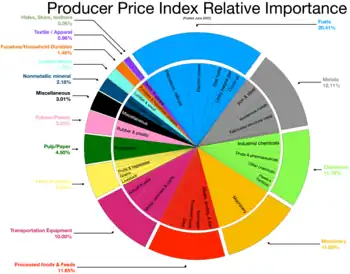Producer price index
Overview


A producer price index (PPI) is a price index that measures the average changes in prices received by domestic producers for their output. Formerly known as the "Wholesale Price Index" between 1902 and 1978, this index is made up of over 16,000 establishments providing approximately 64,000 price quotations that the U.S. Bureau of Labor Statistics (BLS) compiles each month to represent thousands of different goods and services. [2]
Its importance is being undermined by the steady decline in manufactured goods as a share of spending. [3] When manufacturers face increased production costs ("input costs"), businesses must reconsider their pricing approaches:
- Absorbing higher manufacturing costs may maintain customer satisfaction but can impact the company's profitability.
- Transferring those costs to consumers may boost business profits, but it means customers will face higher prices for the goods and services. [4]
PPI Coverage
The PPI system encompasses the production of all industries in the sectors involved in manufacturing goods: [5]
- Mining
- Manufacturing
- Agriculture
- Fishing
- Forestry
- Gas
- Electricity
- Waste
- Scrap materials
Imports are excluded, but locally produced goods that are transported between businesses owned by the same corporation are included. Items produced domestically specifically for the military are also included. [6]
PPI Calculation
The PPI is determined by taking the average weighted prices of goods and services produced in the U.S. for the current month and year, dividing it by the average weighted prices of goods and services produced in the U.S. during a base month and year, and then multiplying the outcome by 100. [7]
For example, let's say the average weighted prices of goods and services in the U.S. during July 2023 are $120, and the average weighted prices during the base month, January 2022, are $100. The PPI for July 2023 would be calculated as follows:
PPI = (Average Weighted Prices in July 2023 / Average Weighted Prices in January 2022) x 100 PPI = ($120 / $100) x 100 PPI = 120
So, the PPI for July 2023 would be 120.
Related measures
A number of countries that now report a producer price index previously reported a wholesale price index.
PPIs around the world
United States
In the US, the PPI was known as the Wholesale Price Index, or WPI, up to 1978. The PPI is one of the oldest continuous systems of statistical data published by the Bureau of Labor Statistics, as well as one of the oldest economic time series compiled by the Federal Government.[9] The origins of the index can be found in an 1891 U.S. Senate resolution authorizing the Senate Committee on Finance to investigate the effects of the tariff laws "upon the imports and exports, the growth, development, production, and prices of agricultural and manufactured articles at home and abroad".[10]
References
- "PPI Tables : U.S. Bureau of Labor Statistics".
- "Producer Price Index Home : U.S. Bureau of Labor Statistics". www.bls.gov. Retrieved 2023-07-24.
- The Economist, Volume 387, May 31 – June 6, 2009, page 109
- "Britannica Money". www.britannica.com. Retrieved 2023-07-24.
- Salvucci, Jeremy (2023-06-15). "What Is the Producer Price Index (PPI) & Why Is It Important?". TheStreet. Retrieved 2023-07-24.
- "Validation request" (PDF). www.conference-board.org. Retrieved 2023-07-24.
- "Producer Price Index Frequently Asked Questions : U.S. Bureau of Labor Statistics". www.bls.gov. Retrieved 2023-07-24.
- "What Does the Producer Price Index Tell You?".
- "Chapter 14 Producer Prices, Background". BLS Handbook of Methods. Archived from the original on 2010-12-13.
- Senate Committee on Finance, Wholesale Prices, Wages, and Transportation, Senate Report No. 1394, "The Aldrich Report," Part I, 52nd Congress, 2d sess., March 3, 1893; and U.S. Department of Labor, Course of Wholesale Prices, 1890–1901, Bulletin No. 39, March 1902, pp. 205–09.
- "New WPI series: India moves to concept of producer price index to better gauge actual price pressure in economy".
- "......it would be desirable to initiate steps to develop a producer price index (PPI) for the country".
